

Concrete-abstract. Brain-Based Learning, Myth versus Reality: Testing Learning Styles and Dual Coding Brain-Based Learning, Myth versus Reality: Testing Learning Styles and Dual Coding Ed.
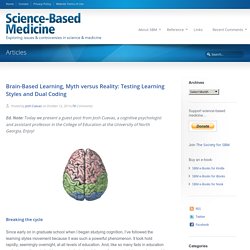
Note: Today we present a guest post from Josh Cuevas, a cognitive psychologist and assistant professor in the College of Education at the University of North Georgia. Enjoy! Breaking the cycle Since early on in graduate school when I began studying cognition, I’ve followed the learning styles movement because it was such a powerful phenomenon. Today when I suggest to students that learning styles are no more than a myth, I can hear their collective jaws drop, regardless of whether they’re undergraduates or graduate students, because learning styles have been preached to them the entire time they’ve been in school.
It has been no easy task combating this common misconception in college classrooms, particularly when it is reinforced in textbooks, by other professors (who are also supposed to know the research), and in public schools where students do their internships. RESEARCH STUDY : The concreteness effect and the bilingual lexicon: The impact of visual stimuli attachment on meaning recall of abstract L2 words. Andrew P.
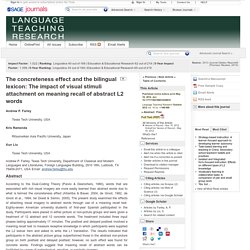
Farley Kris Ramonda Xun Liu Andrew P. Farley, Texas Tech University, Department of Classical and Modern Languages and Literatures, Foreign Languages Building, 2910 18th, Lubbock, TX 79409-2071, USA Email: andrew.farley@ttu.edu According to the Dual-Coding Theory (Paivio & Desrochers, 1980), words that are associated with rich visual imagery are more easily learned than abstract words due to what is termed the concreteness effect (Altarriba & Bauer, 2004; de Groot, 1992, de Groot et al., 1994; ter Doest & Semin, 2005).
The present study examined the effects of attaching visual imagery to abstract words through use of a meaning recall test. Eighty-seven American university students of first-year Spanish participated in the study. . © The Author(s) 2012. Vocabulary Learning in a Second Language: Person, Task, Context and Strategies. Vocabulary Learning in a Second Language: Person, Task, Context and Strategies Peter Yongqi Gu <yqpgu@nie.edu.sg> National Institute of Education Nanyang Technological University Abstract This paper reviews empirical research on vocabulary learning strategies in a second/foreign language.
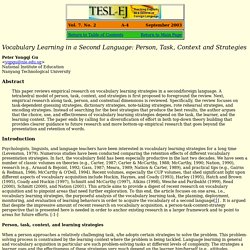
A tetrahedral model of person, task, context, and strategies is first proposed to foreground the review. Next, empirical research along task, person, and contextual dimensions is reviewed. Introduction. 1- Lexique mental et apprentissage des mots. Lors des dernières élections municipales aux Pays-Bas, nous avons entendu une dame prononcer la phrase suivante : au lieu de La dame en question ne se rendait pas compte de son erreur et n’avait pas eu l’intention d’être ironique : elle avait tout simplement mal choisi un mot parmi tous les mots de son lexique mental.
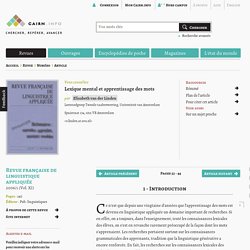
Ce type d’erreurs constitue l’un des domaines de recherches des psychologues du langage, qui se concentrent sur des questions concernant la structure du lexique mental : comment sont organisés les mots dans notre tête ? Comment les êtres humains font-ils pour stocker les mots dans leur mémoire et comment réussissent-ils à les y retrouver ?
Les estimations du nombre des mots que nous possédons dans notre langue maternelle varie de 20.000 à 150.000, mais la plupart des estimations tournent autour de 50.000 (Aitchison, 1987). Mon mari souffre d’une allégorie. où la forme visée était allergie. Le contraire peut également se produire, par exemple lorsque quelqu’un dit : 2- LEARNING VOCABULARY IN EFL CONTEXTS THROUGH VOCABULARY LEARNING STRATEGIES. La théorie du double codage (Paivio, 1971, 1986) 4.1.2.a La théorie du double codage (Paivio, 1971, 1986) À l’origine, la théorie du double codage a été proposée par Paivio (1971, 1986) pour donner une explication hypothétique aux effets bénéfiques de l’activité d’imagerie sur la mémoire verbale ainsi que pour rendre compte des comparaisons que l’on peut faire entre cette mémoire et celle d’un matériel constitué de dessins d’objets (Florès, 1987).
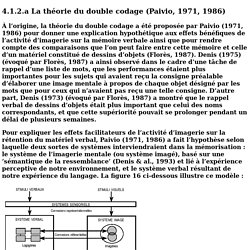
Denis (1975) (évoqué par Florès, 1987) a ainsi observé dans le cadre d’une tâche de rappel d’une liste de mots, que les performances étaient plus importantes pour les sujets qui avaient reçu la consigne préalable d’élaborer une image mentale à propos de chaque objet désigné par les mots que pour ceux qui n’avaient pas reçu une telle consigne. Analyse de donn ́ees en apprentissage d’une L2 en situation d’autonomie dans un environnement multim ́edia. The_Impact_of_Digital_Technologies_on_Learning_(2012)